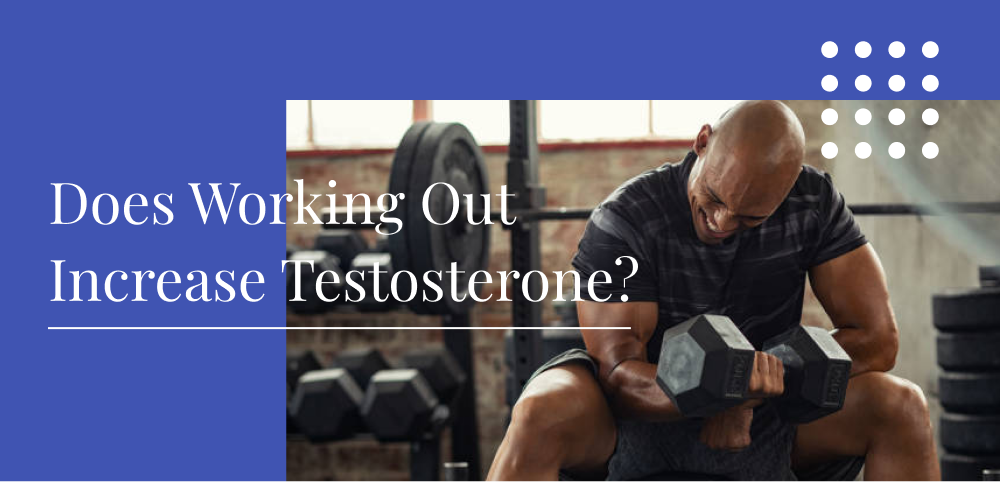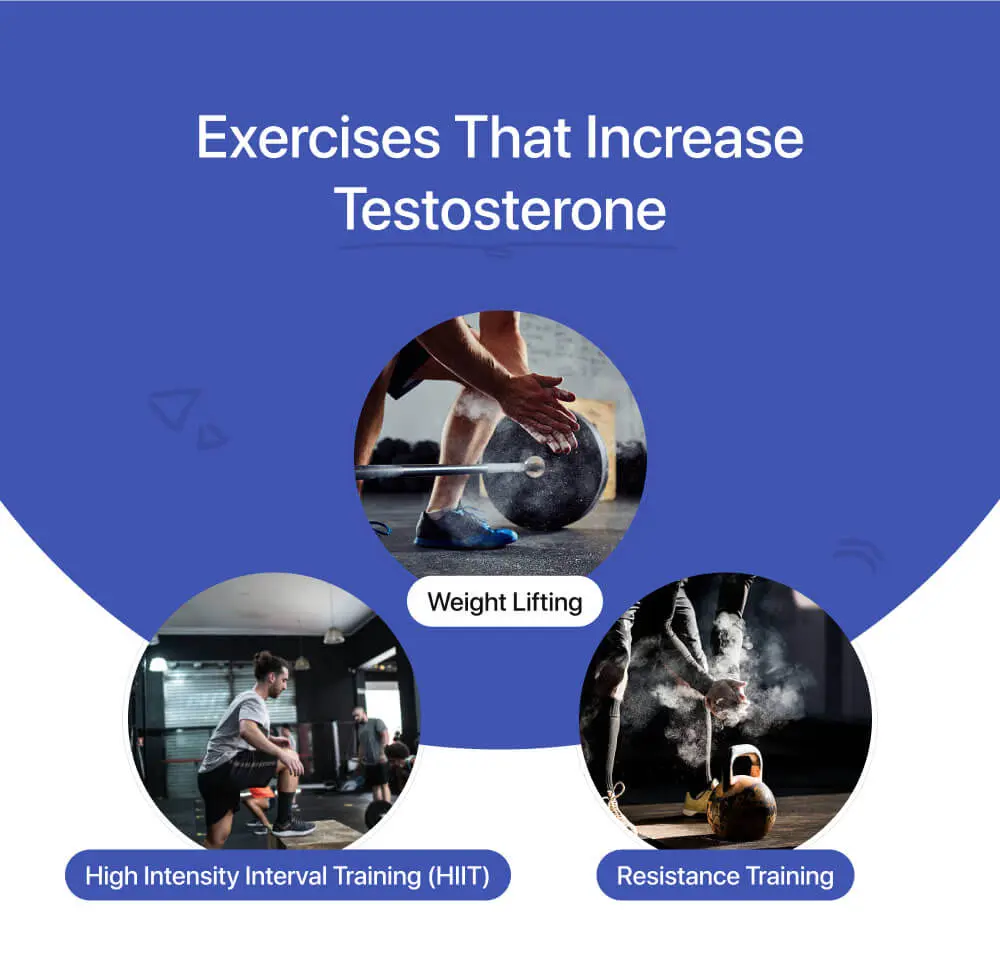Increasing testosterone in a natural and safe way is desired by many people. While working out can definitely do the trick, beginners can make many mistakes that set them back. They may not exercise with enough intensity, or they may overdo it.
There are also different kinds of exercise. You have aerobic exercises like cardio, and there’s resistance training. We’ll go into detail about each type of exercise, what role testosterone plays in the body and why it’s so vital.
Key Takeaways
- Balanced levels of testosterone are needed in both men and women for optimal health
- Women produce small amounts of testosterone in the adrenal glands and ovaries, in addition to other hormones
- Testosterone plays a key role in muscle strength and other male attributes
- Exercises, particularly weight training and HIIT, can boost testosterone
- Supplements, diet, age, and lifestyle choices can impact testosterone production
What Does Testosterone Do For The Body?
Testosterone is typically known as the male sex hormone, but it plays an important role in both men and women [1].
This important hormone is responsible for a multitude of effects, including maintaining bone density, muscle mass, good mood, energy levels, body hair, sex drive, red blood cell production, and overall health. It’s also one of the key sex hormones involved in male puberty.
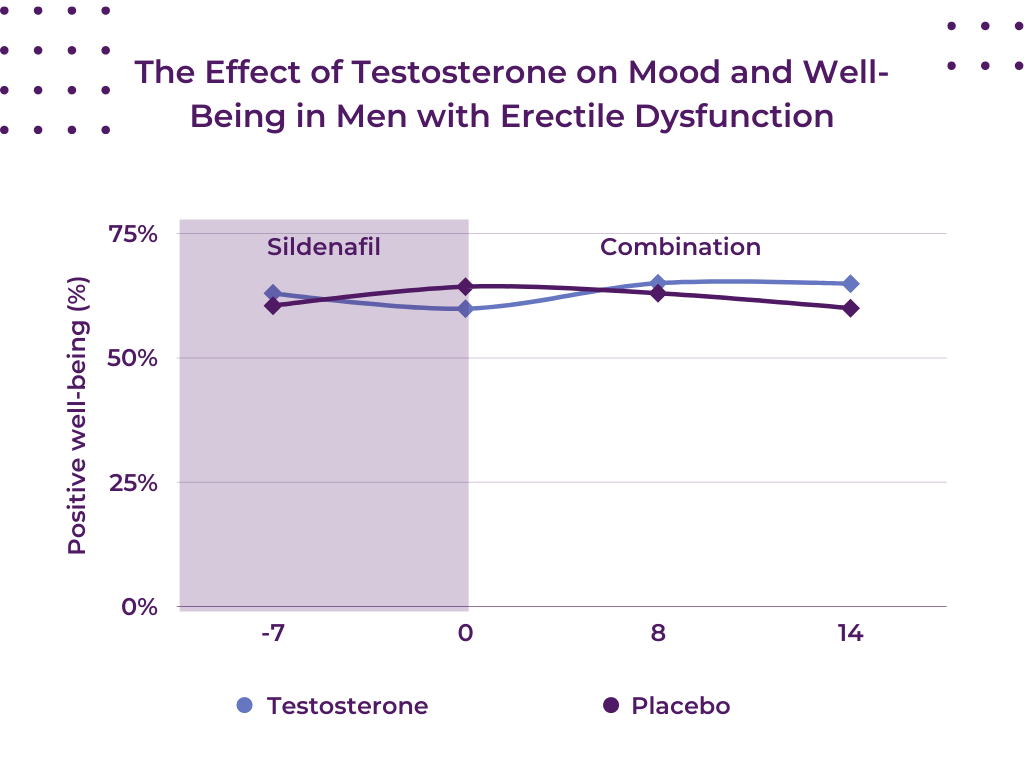
Source: https://www.ncbi.nlm.nih.gov/pmc/articles/PMC3630276/
Low testosterone levels can result in many adverse effects, including low libido, fatigue, depression, difficulty concentrating, decreased mental reaction time, and increased levels of fat. Low testosterone in women can also cause problems, but typically these effects are more subtle.
In some cases, you may want to know how to lower testosterone as too much testosterone production can be troublesome too. For instance, it can result in increased aggressive behavior, acne, oily skin, and irritability. Maintaining healthy testosterone levels is ideal for both men and women.
Summary
Testosterone is a key sex hormone found in both men and women, which plays many roles. Having appropriate t levels is important to avoid any adverse health effects.
Working Out and Testosterone
There’s a proven relationship between t levels and exercise. However, it’s important to do the right kind of activity at the optimal intensity for the best results. Otherwise, you may even find you’ll get the opposite effect of what you intended.
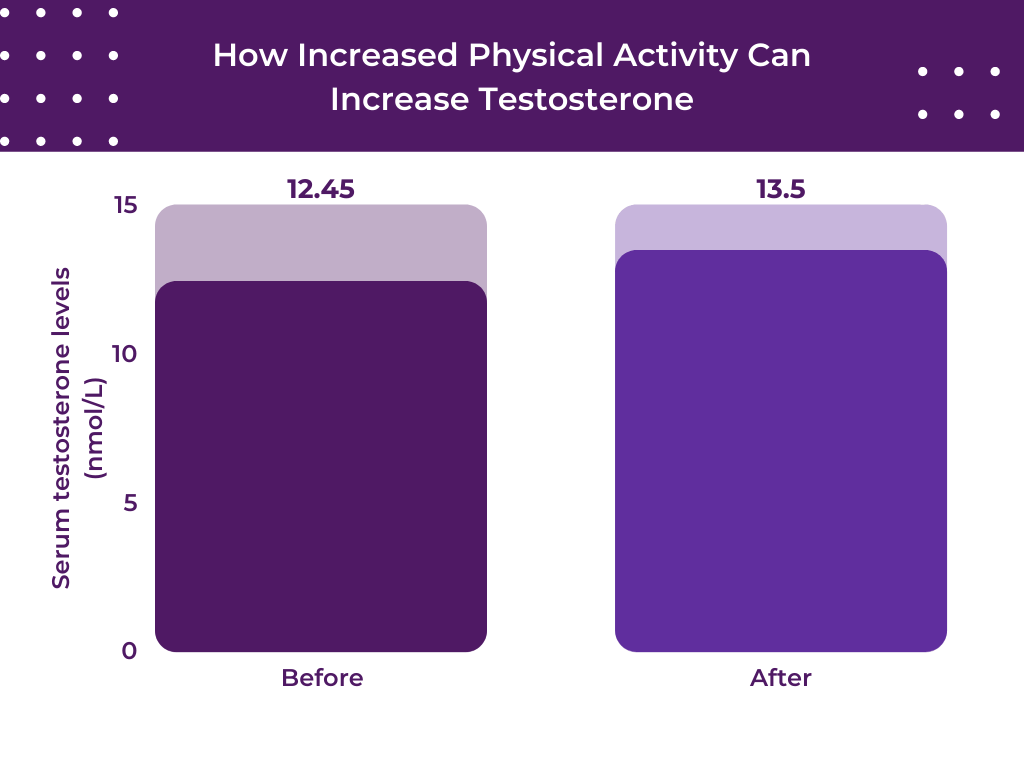
Source: https://www.ncbi.nlm.nih.gov/pmc/articles/PMC4706091/
Does Testosterone Increase After Working Out?
Can exercise increase testosterone? Numerous studies have been carried out to measure the effects of exercise on testosterone levels [2]. For example, the serum testosterone levels of participants are checked before and after exercise to measure the changes.
It’s been shown that exercise can indeed boost testosterone. However, the increase tends to be temporary, so you need a regular routine to reap the most benefits.
Does Exercise Increase Testosterone in Females?
Yes, workouts can also increase testosterone levels in women too [3]. However, as women naturally have lower t levels than men, these increases are much more subtle.
Summary
Exercise has been shown to increase levels of testosterone in both men and women. The magnitude of the increase in testosterone levels is affected by several factors like gender, age, the kind of exercise, and intensity.
How To Raise Testosterone levels
Here’s where we’ll cover exactly which exercises are proven to be the best for boosting testosterone levels and which ones you might want to avoid. In addition to exercise, there are various foods and supplements available that claim to increase t levels, and we’ll explain those too.
What Exercise Increases Testosterone Most?
Weight lifting has widely been shown as one of the best exercises for increasing testosterone levels. The benefits of weight training and testosterone also go hand in hand. Steroid hormones like testosterone and resistance training both lead to muscle growth, gaining lean muscle mass, and improving overall body composition.
Lifting heavier weights, having shorter rest periods, and using more muscle groups together is beneficial. In other words, you want a full body workout like squats rather than working muscles in isolation.
However, overdoing it can result in higher levels of cortisol, which is a stress hormone. This can ultimately cause t levels to actually go down and result in low t. You also need long enough rest periods in between resistance training sessions to give muscles enough time for recovery.
So while strength training can give a testosterone boost, it’s important to keep your fitness level in mind and not go beyond what you’re capable of. Since the benefits can wane, a regular exercise program is key.
High Intensity Interval Training (HIIT)
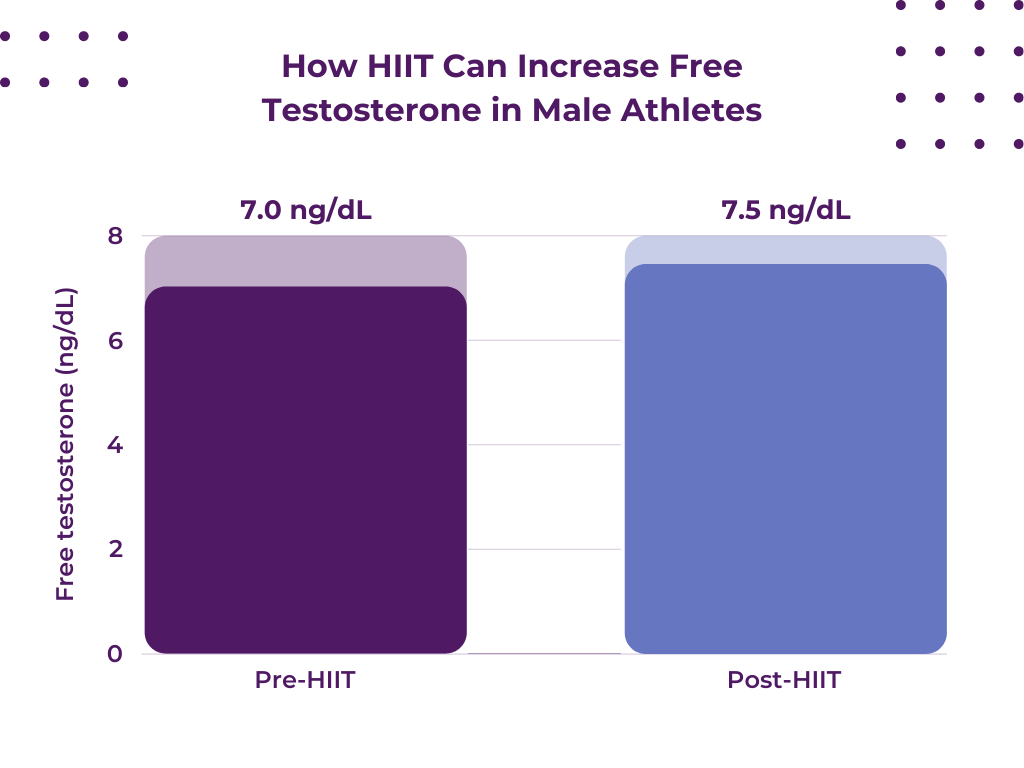
Source: https://www.ncbi.nlm.nih.gov/pmc/articles/PMC5551442/#:~:text=High%2Dintensity%20interval%20training%20(HIIT,examined%20in%20masters%20endurance%20athletes.&text=Six%20weeks’%20HIIT%20improves%20PPO,athletes%20and%20increases%20free%20testosterone
Besides lifting weights, high intensity interval training has been shown to boost testosterone [4]. As the name suggests, you do the exercises (such as stair climbing, rowing, or jumping rope) at a high intensity for periods of 30 seconds to three minutes. Afterward, you rest for the same time and get back to it.
Intensive interval training isn’t for everyone, though. If you’re not in great shape you might want to start out with some more basic endurance training and strength training first. Once you have a better level of fitness, you can engage in HIIT as testosterone responses are better than with steady state endurance exercise.
Does Running Increase Testosterone?
The effects of running on testosterone levels can be quite different from resistance exercise. Research has shown running can even result in low t rather than raising testosterone. The exact mechanism isn’t fully understood, but it’s thought to relate to excess cortisol production [5]. Endurance athletes have sometimes been shown to have lower t levels.
Cortisol is typically produced in response to higher stress levels. This hormone can have disastrous effects on fat distribution and even cause you to lose muscle mass and reduce bone density. It’s quite literally the opposite of what we’re looking to achieve through exercise.
Can Cardio Raise Testosterone?
Cardio refers to any type of exercise that gets your heart rate up. Running can be considered one of the most basic cardio exercises. Although cardio has been shown to decrease t levels, that doesn’t mean you should skip it.
Endurance exercise is still important for any workout plan. Strength training alone won’t help prevent every chronic disease, and it’s important to have a high level of endurance and overall fitness. Physically active men show healthier hormone values, semen parameters, and testosterone increases.
Are There Other Ways To Boost Testosterone?
Yes! There are plenty of ways to naturally increase testosterone levels. Vitamin supplements, a healthy diet, and certain herbs can have a positive impact on your testosterone level. There are also certain foods that increase testosterone.
In men with certain chronic diseases, it may be possible to receive prescription testosterone replacement therapy. This can help achieve healthy hormone levels where lifestyle and dietary changes alone don’t suffice.
Summary
Exercise has been shown to boost testosterone levels, but the greatest benefits come from weight training and intense interval workouts. Maximum effort, with exercises that engage the most muscles, is needed for the highest effect. These benefits are seen in both genders but increases are more notable in men.
FAQ
Below is a list of the most frequently asked questions and answers about exercise and testosterone.
Can Testosterone Be Increased?
Yes, as we’ve seen, you can raise testosterone through several natural means and without any drugs. For example, flaxseed effects on testosterone have been shown in studies. Nuts and seeds can also be used to gain weight in a healthy way and support optimal health.
How Long Does It Take For Exercise to Increase Testosterone?
The answer here is that it depends on several factors. Your gender, age, overall health, and type of exercise you’re doing are all important. According to Todd Schroeder, a researcher at the University of Southern California, increases in testosterone levels can occur anywhere from 15 minutes to an hour after a workout session.
Does Masturbation Decrease Testosterone?
There are many myths and misunderstandings surrounding the relationship between masturbation and testosterone levels. For example, many men believe that semen retention and abstaining from masturbation will result in boosts of testosterone levels.
Ultimately research has shown that masturbation has no long-term effects on testosterone levels [6]. It may, however, have some short-term effects.
Conclusion
It’s possible to raise your t levels with resistance training and HIIT. Running and other endurance exercises can have an adverse effect on t levels. It’s hypothesized that prolonged endurance workouts result in higher levels of stress hormones which then result in decreased t levels.
Exercise is only one part of the picture, though. You shouldn’t forget the importance of diet and balanced nutrition. Your body needs the right materials to produce hormones, build muscle and carry out other important functions. While certain supplements can also help, you should be wary of testosterone killing foods.
References
- Nassar, George N. “Physiology, Testosterone.” StatPearls [Internet]., U.S. National Library of Medicine, 4 Jan. 2022, https://www.ncbi.nlm.nih.gov/books/NBK526128/.
- Hayes, Lawrence D., and Bradley T. Elliott. “Short-Term Exercise Training Inconsistently Influences Basal Testosterone in Older Men: A Systematic Review and Meta-Analysis.” Frontiers, Frontiers, 1 Jan. 1AD, https://www.frontiersin.org/articles/10.3389/fphys.2018.01878/full.
- Nindl BC;Kraemer WJ;Gotshalk LA;Marx JO;Volek JS;Bush FA;Häkkinen K;Newton RU;Fleck SJ; “Testosterone Responses after Resistance Exercise in Women: Influence of Regional Fat Distribution.” International Journal of Sport Nutrition and Exercise Metabolism, U.S. National Library of Medicine, https://pubmed.ncbi.nlm.nih.gov/11915780/.
- Ambroży T;Rydzik Ł;Obmiński Z;Błach W;Serafin N;Błach B;Jaszczur-Nowicki J;Ozimek M; “The Effect of High-Intensity Interval Training Periods on Morning Serum Testosterone and Cortisol Levels and Physical Fitness in Men Aged 35-40 Years.” Journal of Clinical Medicine, U.S. National Library of Medicine, https://pubmed.ncbi.nlm.nih.gov/34063524/.
- Hackney, A C, and Eser Aggon. “Chronic Low Testosterone Levels in Endurance Trained Men: The Exercise- Hypogonadal Male Condition.” Journal of Biochemistry and Physiology, U.S. National Library of Medicine, 2018, https://www.ncbi.nlm.nih.gov/pmc/articles/PMC5988228/.
- JW;, Jiang M;Xin J;Zou Q;Shen. “A Research on the Relationship between Ejaculation and Serum Testosterone Level in Men.” Journal of Zhejiang University. Science, U.S. National Library of Medicine, https://pubmed.ncbi.nlm.nih.gov/12659241/.
